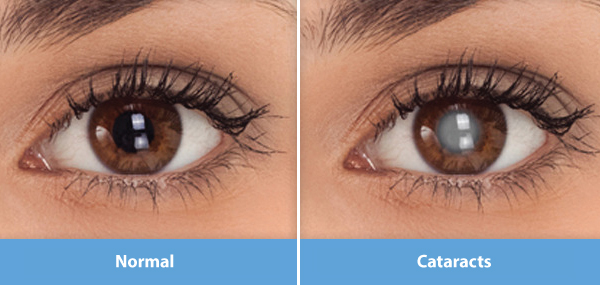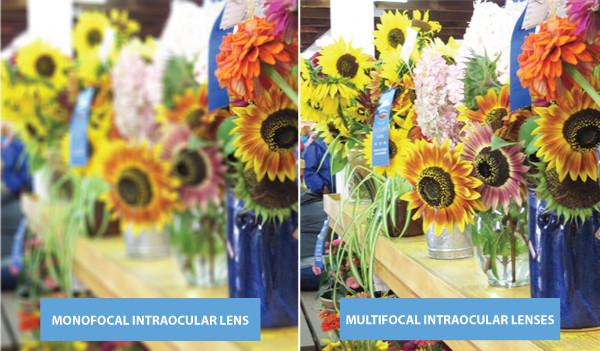What is Cataracts?
[/plethora_headinggroup]
A cataract is a clouding of the eye’s natural lens, which lies behind the iris and the pupil. Cataracts are the most common cause of vision loss in people over the age 40 and is the principal cause of blindness in the world. In fact, there are more cases of cataracts worldwide than there are of glaucoma, macular degeneration and diabetic retinopathy combined, according to Prevent Blindness America (PBA).
Today, cataracts affect more than 22 million Americans age 40 and older. And as the U.S. population ages, more than 30 million Americans are expected to have cataracts by the year 2020, PBA says.
What Causes Cataracts?
[/plethora_headinggroup]
The lens inside the eye works much like a camera lens, focusing light onto the retina for clear vision. It also adjusts the eye’s focus, letting us see things clearly both up close and far away.
The lens is mostly made of water and protein. The protein is arranged in a precise way that keeps the lens clear and lets light pass through it. But as we age, some of the protein may clump together and start to cloud a small area of the lens. This is a cataract, and over time, it may grow larger and cloud more of the lens, making it harder to see.
No one knows for sure why the eye’s lens changes as we age, forming cataracts. But researchers worldwide have identified factors that may cause cataracts or are associated with cataract development. Besides advancing age, cataract risk factors.
- Ultraviolet radiation from sunlight and other sources
- Diabetes
- Hypertension
- Obesity
- Smoking
- Prolonged use of corticosteroid medications
- Statin medicines used to reduce cholesterol
- Previous eye injury or inflammation
- Previous eye surgery
- Hormone replacement therapy
- Significant alcohol consumption
- High myopia
- Family history

DO I HAVE CATARACTS?
- I am over the age of 55
- My eyes are clouding and I can not tell the colors apart
- Can not see close objects well
- When driving at night, the lights from cars are spread in all directions.
- When I am wearing glasses of magnifying glasses, my vision is still not clear
- Even when I am looking through one eye, I see objects overlapping
- My vision is uncomfortable in bright places and near vision is deteriorated.
- My visual acuity improves indoors or in the dark.
- It is difficult to distinguish a person coming from afar.
※ If you have recently experienced a change in vision, take a vision test.

Normal Vision

Cataracts Vision
TYPES OF CATARACTS
[/plethora_headinggroup]
SENILE CATARACT
Senile cataract is an age-related, vision-impairing disease characterized by gradual progressive thickening of the lens of the eye. It is the world’s leading cause of treatable blindness.
TRAUMATIC CATARACT
Traumatic cataracts occur secondary to blunt or penetrating ocular trauma. Infrared energy (glass-blower’s cataract), electric shock, and ionizing radiation are other rare causes of traumatic cataracts. Classic rosette-shaped cataract in a 36-year-old man, 4 weeks after blunt ocular injury.
MATURE CATARACT
As a cataract progresses, more of the lens becomes cloudy. When the entire lens is white, the cataract is called a “ripe” or “mature” cataract and causes severe vision problems. Delaying surgery until cataracts are ripe or mature is neither recommended nor needed.
DIABETIC CATARACT
Diabetes and Cataracts. Cataract is a condition where the eye’s naturally clear lens becomes cloudy, or opaque. Light doesn’t pass through the lens as it should and isn’t properly reflected onto the retina (the light-sensitive tissue lining the back of the eye). As a result, vision becomes cloudy, distorted or blurry.
CONGENITAL CATARACT
A congenital cataract is a clouding of the lens of the eye that is present at birth. The lens of the eye is normally clear. It focuses light that comes into the eye onto the retina.
POSTERIOR CATARACT
Posterior Subcapsular Cataracts. This type of cataract begins as a small opaque or cloudy area on the “posterior,” or back surface of the lens. It is called “subcapsular” because it forms beneath the lens capsule, which is a small “sac,” or membrane, that encloses the lens and holds it in place.

CATARACT SYMPTOMS
[/plethora_headinggroup]
Sometimes when you look in the mirror or when someone looks at the naked eye, there are things that are white in your eyes. In almost all cases, cataracts can not be distinguished by the naked eye. You can visit your ophthalmologist and diagnose the presence of cataracts through special equipment.
COMMON SYMPTOMS OF CATARACTS INCLUDE:
- blurry vision
- trouble seeing at night
- seeing colors as faded
- increased sensitivity to glare
- halos surrounding lights
- double vision in the affected eye
- a need for frequent changes in prescription glasses
CATARACT TREATMENT METHOD
[/plethora_headinggroup]
You do not have to undergo surgery if you have early cataracts, but you should consult your doctor if you feel uncomfortable with your daily life. If you miss the timing without the discomfort, the postoperative satisfaction may be less and the complications may be caused.
NON-SURGICAL TREATMENT
Injection / Drug : Expected to delay progression rate in early cataract
SURGICAL TREATMENT
Operation method : Insertion Multifocal Intraocular Lenses
Surgical subject : Patients with cataracts who have undergone visual acuity loss and impairment and progressed to such an extent that the effects of medication can not be expected
Type of surgery : Single Focus / Multifocal / Continuous Focus Intraocular Lenses

One focus : Monofocal intraocular lens
Because it focuses on only one of the near or far focus, it has excellent distance or near vision quality.
More than two focal points : Multifocal intraocular lens
By focusing on multiple objectives, both near and far vision can be improved, and cataract as well as presbyopia can be treated. Unlike monochromatic intraocular lenses, it also improves vision without the need for a magnifying glass or glasses.
Continuous focus : Intraocular lens
It provides continuous focus from near distance to medium distance, distance to distance and focus distance. You can lower your glasses dependency in everyday life.
FREQUENTLY ASKED QUESTIONS ABOUT CATARACTS?
Q. When should I receive surgery?
A. Cataracts does not require surgery immediately after diagnosis like other emergencies.
We usually recommend surgery when you feel uncomfortable in your daily life. However, if the cataract is advanced, it is not only difficult to perform surgery but there is also a risk of getting glaucoma. Therefore, it is necessary to have a regular checkup at least every 6 months after diagnosis of cataract.
Q. Do you have to surgery both eyes at once?
A. Bilateral cataract surgery is usually not performed on the same day nor at the same time. After having monocular surgery, you can see the vision of the operated eye and predict the frequency of the opposite eye more accurately.
Q. Can I have surgery if I am Old?
A. Because cataract surgery is usually performed under local anesthesia, age is not a problem as long as healthy enough to be able to cooperate during surgery.
COMMON MYTHS ABOUT CATARACTS?
1) If one eye develops cataracts, can the other eye get cataracts too?
No. Cataracts can not translate from one eye to the other. However, it is possible to get cataracts in both eyes at the same time.
2) Cataracts are caused by constantly using your eyes?
No. Using your eyes “constantly” does not cause you to get cataracts nor does it make your cataracts worse
3) If you have cataracts, do you need surgery?
No. Early cataracts do not require surgery.
4) Can my cataracts disappear if I eat well and apply medicine as soon as I am diagnosed?
No. Once you have been diagnosed with cataracts, it will not improve through treatment.
ARE YOU CURIOUS ABOUT THE APPLICATION FOR EXAMINATION, THE METHOD OF EXAMINATION, AND THE COST OF SURGERY?
[/plethora_headinggroup][plethora_button button_text=”Call (213) 384-5222″ button_link=”url:tel%3A2133845222|||” button_align=”text-center” button_style=”btn-primary” button_with_icon=”with-icon” button_icon=”fa fa-phone” button_icon_align=”icon-left”]